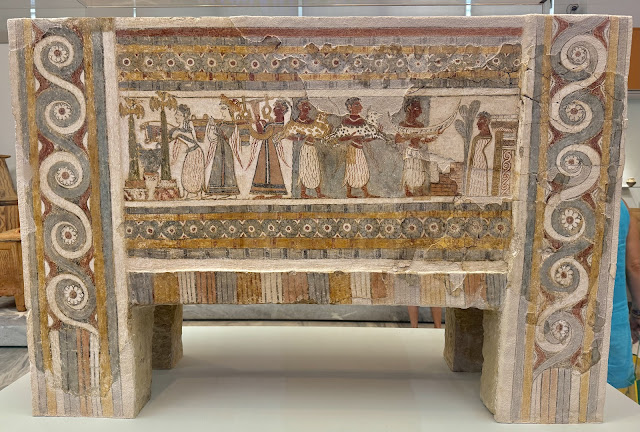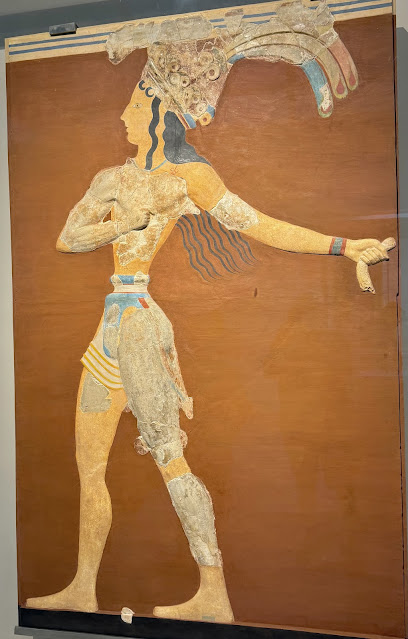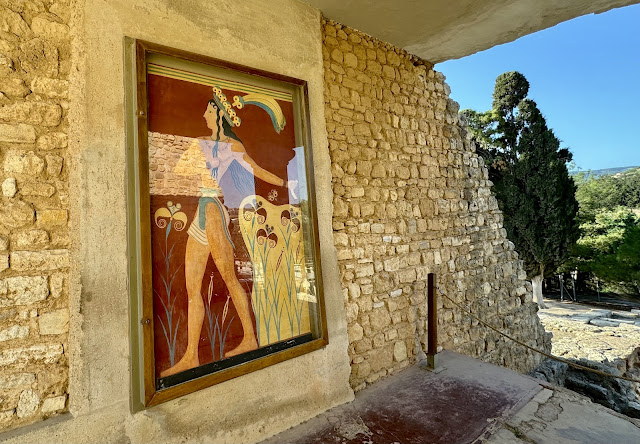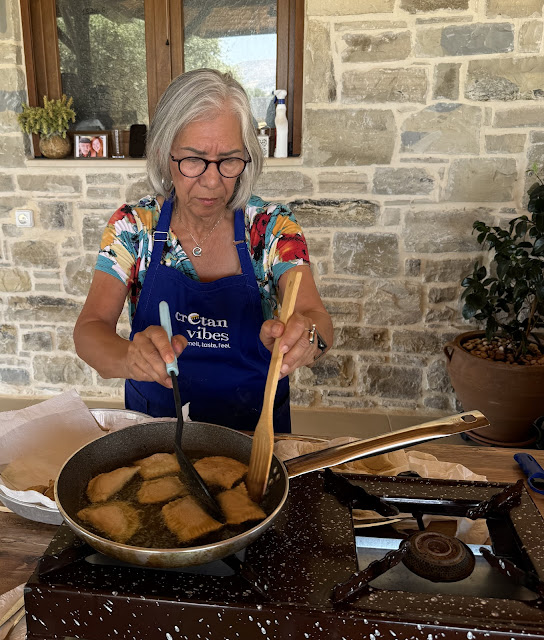Crete to me is a magical island. The high mountains, the beautiful beaches, the ancient Minoan civilization, the famous wild goats.
We managed to find a magical place to stay: a small villa just outside the little village of Dafnis in the middle of Crete's wine country.
We had a hard time finding the place at first, driving our rented car up and down various rough back roads (no such thing as an address, just a point on the map), but once we found it, we were quickly enchanted by the beauty and tranquility of the setting. The days were hot and the sun intense, but the evenings were the perfect time to swim in the little pool and watch the sun set behind the mountains.
Greeks in general, and Cretans especially, love their coffee. We were surprised to find much better coffee in Greece than the mediocre stuff we had in France. In Crete, as in Athens, there were coffee shops everywhere. Which is probably what keeps the Cretans hopping.
There are very few cows on the island. It's a caprine paradise, and the ubiquitous ungulates have made their mark on every phase of island life.
Also there are dinosaurs. We visited the Heraklion Natural History Museum and were impressed by the quantity and quality of the life-size dinosaur models, many of which were animatronic.
There was also a display of various live small animals native to Crete, like this spotted frog.
Stuffed specimens like this big-horned sheep.
And a couple of Cretan wild goats.
Luciya lost her head over the exhibit of optical illusions.
The locals were cooling off in the limpid waters of Heraklion Bay. The sun was brutal, and the humidity, though lower than in Athens, was high enough to be uncomfortable for semi-desert dwellers like us.
We had to pause for a hydration break, and I found a small bottle of retsina to console myself.
The Heraklion Archeological Museum has thousands of artifacts of the Minoan civilization dating back to as early as 3100 BCE. It's thought that the massive eruption of the volcano on the neighboring island of Thera (now Santorini), one of the most catastrophic eruptions known, contributed to the collapse of the Minoan civilization in around 1500 BCE.
Very little is known about the Minoan culture, but many wonderful artifacts have been excavated from the vast city/palace of Knossos.
Apparently there were many robberies in Minoan times.
Two snake goddesses/priestesses.
Though there are few cows on the island today, the Cretan bull is famous in Greek mythology. Poseidon sent a very handsome bull to Crete, and the queen, Pasiphae, fell in love with it. Well, really more lust, because the queen, looking for love in all the wrong places, ordered the inventor Daedalus to build a wooden cow that she could disguise herself in and so lure the bull to mate with her. She subsequently gave birth to a son with the head of a bull--the minotaur. Later Hercules, as his seventh labor, was tasked to capture the bull and bring it to Greece. He succeeded (of course) but the bull was pissed and proceeded to terrorize the countryside until it was finally killed by Theseus. That would be the same Theseus who entered the labyrinth at Knossos and killed the minotaur, the bull's son.
Greek mythology is almost as complicated as the Marvel Universe.
King Minos may not have been an actual person, but looking at this model of the palace of Knossos, you can see how the legend of the labyrinth came about.
Artwork shows a very sophisticated civilization. It's too bad so little is actually known of it. But you can see that they were hopping even way back then.
Crete is a huge island, second only to Sicily in the Mediterranean. The White Mountains, running through the center of the island, are tall enough to still have patches of snow in June when the temperature at sea level is in the high 90s.
We took a road trip from Heraklion to the far west of the island, about 100 miles each way.
We stopped at Gramvousa restaurant for lunch. Gramvousa is a part of the Cretan farm-to-table movement. The restaurant is attached to a working farm, and almost everything they serve is locally sourced, including the delicious Cretan wines. We were amazed at the freshness and variety of the local foods showcased at many of the restaurant here. The island is becoming a foodie destination.
On our way back to Dafnis, we stopped in Chania, an old port city that was the island's capital under Venetian rule. The old town section is very charming,
Many of the Venetian fortifications are still standing.
Road-tripping in Greece can be a bit confusing at times. First of all, there's the signage. In the Greek alphabet. When I was in high school, I memorized the Greek and Russian alphabets, which are similar (I was a weird kid). A lot of it came back to me as I tried to decipher the road signs. Of course, in the tourist areas, the signs are usually Anglicized. But that can be a problem, too. We finally realized that there were often three different spelling used somewhat interchangeably--the Greek version in the Greek alphabet, a transliteration of the Greek name, and/or the Anglicized version of the Greek name.
So, for example, Heraklion would appear as Ἡράκλειον, Irakleio, or Heraklion. Luckily, we could just follow Google maps and not worry about it.
And the scenery was definitely worth the confusion.
We took an all-day trip on the SeaJet ferry to Santorini from Heraklion. The trip is about 60 miles and takes a couple hours. The ferry is massive and crammed with tourists.
Santorini is the remains of a volcano that blew up with the force of about two million Hiroshima atomic bombs sometime between 1700 and 1500 BCE. The explosion caused crop failures as far away as China, and the tsunami that follow devastated the thriving Minoan civilization, sending it into a downward spiral from which it never recovered.
The huge caldera is surrounded by high cliffs now covered by the quaint whitewashed building so beloved by tourists from all over the world.
It's a beautiful, serene place these days.
The viewpoints are jammed with tourists, but the charming back streets are perfect for strolling.
The quality of light is remarkable, clear and bright, with a pellucidity makes my heart happy. The sea is a deep, calm blue, edged with turquoise.
Happy to be alive.
Made for photo ops.
The church on the main square is decorated in Greek Orthodox style, so different from the Catholic churches of Europe.
The island makes its own wine. Because of the wind and the lack of water, the vines are planted as low bushes instead of being trained onto wires. We saw this type of viniculture on the island of Pantelleria off the coast of Sicily.
Santorini, like most of the Greek islands, is being hard hit by a combination of climate change caused drought and the overuse of water by the tourist industry. The course is unsustainable, but there seems to be no constituency for change.
On our last day, we toured the ruins of the palace of Knossos. It's a huge site, very little of which has actually been excavated. Little is actually known about Minoan civilization, and the reconstruction of the palace is speculative, based on the work of the British archeologist, Sir Arthur Evans, between 1896 and 1921.
There are peacocks.
Reproductions of the murals now in the museum at Heraklion are placed on the walls where they used to be. It's an impressive site, well worth a visit. And an opportunity to do some speculation of your own.
After Knossos, we head south to the middle of the island for a cooking class: Cretan Vibes!
The class is run by a mother and daughter on their beautiful family farm.
They have a lovely open-air kitchen in which they host classes seven days a week.
We cooked a full meal--lamb stew, appetizers, and the tasty sweet cheese pockets O is studiously frying up.
Stuffed squash blossoms and dolmas, too!
On the way back to the airport, we had a great view of the snow-flecked peak of Mt. Ida, the highest mountain in Crete at just over 8,000 feet.
I was sorry to leave this magnificent landscape.
But we were leaving on a jet plane bound for Athens and the little island of Sifnos.






















































No comments:
Post a Comment